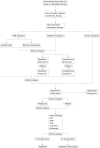Microscopic colitis
- PMID: 23180940
- PMCID: PMC3501768
- DOI: 10.3748/wjg.v18.i43.6206
Microscopic colitis
Abstract
Microscopic colitis may be defined as a clinical syndrome, of unknown etiology, consisting of chronic watery diarrhea, with no alterations in the large bowel at the endoscopic and radiologic evaluation. Therefore, a definitive diagnosis is only possible by histological analysis. The epidemiological impact of this disease has become increasingly clear in the last years, with most data coming from Western countries. Microscopic colitis includes two histological subtypes [collagenous colitis (CC) and lymphocytic colitis (LC)] with no differences in clinical presentation and management. Collagenous colitis is characterized by a thickening of the subepithelial collagen layer that is absent in LC. The main feature of LC is an increase of the density of intra-epithelial lymphocytes in the surface epithelium. A number of pathogenetic theories have been proposed over the years, involving the role of luminal agents, autoimmunity, eosinophils, genetics (human leukocyte antigen), biliary acids, infections, alterations of pericryptal fibroblasts, and drug intake; drugs like ticlopidine, carbamazepine or ranitidine are especially associated with the development of LC, while CC is more frequently linked to cimetidine, non-steroidal antiinflammatory drugs and lansoprazole. Microscopic colitis typically presents as chronic or intermittent watery diarrhea, that may be accompanied by symptoms such as abdominal pain, weight loss and incontinence. Recent evidence has added new pharmacological options for the treatment of microscopic colitis: the role of steroidal therapy, especially oral budesonide, has gained relevance, as well as immunosuppressive agents such as azathioprine and 6-mercaptopurine. The use of anti-tumor necrosis factor-α agents, infliximab and adalimumab, constitutes a new, interesting tool for the treatment of microscopic colitis, but larger, adequately designed studies are needed to confirm existing data.
Keywords: Anti-tumor necrosis factor-α agents; Collagenous colitis; Immunosuppressive agents; Lymphocytic colitis; Microscopic colitis; Watery diarrhea.
Figures
References
-
- Read NW, Krejs GJ, Read MG, Santa Ana CA, Morawski SG, Fordtran JS. Chronic diarrhea of unknown origin. Gastroenterology. 1980;78:264–271. - PubMed
-
- Lindström CG. ‘Collagenous colitis’ with watery diarrhoea--a new entity? Pathol Eur. 1976;11:87–89. - PubMed
-
- Lazenby AJ, Yardley JH, Giardiello FM, Jessurun J, Bayless TM. Lymphocytic (“microscopic”) colitis: a comparative histopathologic study with particular reference to collagenous colitis. Hum Pathol. 1989;20:18–28. - PubMed
-
- Fernández-Bañares F, Salas A, Forné M, Esteve M, Espinós J, Viver JM. Incidence of collagenous and lymphocytic colitis: a 5-year population-based study. Am J Gastroenterol. 1999;94:418–423. - PubMed
Publication types
MeSH terms
Substances
LinkOut - more resources
Full Text Sources


